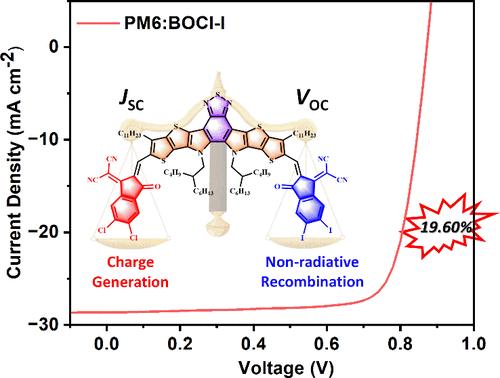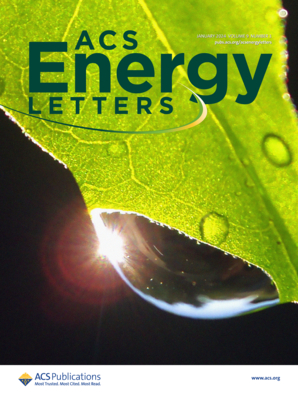Reducing the Trade-Off between Charge Generation and Nonradiative Voltage Loss via Asymmetric Strategy Enables Binary Organic Solar Cells over 19.5%
IF 18.2
1区 材料科学
Q1 CHEMISTRY, PHYSICAL
引用次数: 0
Abstract
Halogenation and asymmetry strategy on the 2-(3-oxo-2,3-dihydroinden-1-ylidene)malononitrile (INCN) terminal groups are effective approaches for constructing efficient nonfullerene acceptors (NFAs). In this study, we introduced iodine-based I-INCN and the chlorine-based Cl-INCN into one molecule named BOCl-I, in which I-INCN is beneficial for suppressing nonradiative recombination and Cl-INCN makes for charge generation. An impressive power conversion efficiency (PCE) of 19.60% was achieved in the PM6:BOCl-I-based device, which is one of the champion PCEs among the reported binary organic solar cells to date. Detailed analyses revealed that the PM6:BOCl-I based device strikes a balance between efficient charge generation and suppressed nonradiative recombination, leading to a low nonradiative voltage loss of 0.228 eV and higher short circuit current density of 28.7 mA·cm–2. This work demonstrates a feasible way to reduce the trade-off between charge generation and nonradiative recombination via the synergetic effect of halogenation and asymmetric strategy.

通过非对称策略减少电荷产生和非辐射电压损失之间的权衡,使二元有机太阳能电池超过19.5%
2-(3-氧-2,3-二氢茚-1-乙基)丙二腈(INCN)端基卤化和不对称策略是构建高效非富勒烯受体(nfa)的有效途径。在本研究中,我们将基于碘的I-INCN和基于氯的Cl-INCN引入到一个名为BOCl-I的分子中,其中I-INCN有利于抑制非辐射重组,而Cl-INCN有利于电荷的产生。PM6: bocl - i基器件的功率转换效率(PCE)达到了19.60%,是目前报道的二元有机太阳能电池中功率转换效率最高的器件之一。详细分析表明,基于PM6: bocl - 1的器件在有效电荷产生和抑制非辐射复合之间取得了平衡,从而实现了0.228 eV的低非辐射电压损失和28.7 mA·cm-2的高短路电流密度。这项工作展示了一种可行的方法,通过卤化和不对称策略的协同效应来减少电荷产生和非辐射重组之间的权衡。
本文章由计算机程序翻译,如有差异,请以英文原文为准。
求助全文
约1分钟内获得全文
求助全文
来源期刊

ACS Energy Letters
Energy-Renewable Energy, Sustainability and the Environment
CiteScore
31.20
自引率
5.00%
发文量
469
审稿时长
1 months
期刊介绍:
ACS Energy Letters is a monthly journal that publishes papers reporting new scientific advances in energy research. The journal focuses on topics that are of interest to scientists working in the fundamental and applied sciences. Rapid publication is a central criterion for acceptance, and the journal is known for its quick publication times, with an average of 4-6 weeks from submission to web publication in As Soon As Publishable format.
ACS Energy Letters is ranked as the number one journal in the Web of Science Electrochemistry category. It also ranks within the top 10 journals for Physical Chemistry, Energy & Fuels, and Nanoscience & Nanotechnology.
The journal offers several types of articles, including Letters, Energy Express, Perspectives, Reviews, Editorials, Viewpoints and Energy Focus. Additionally, authors have the option to submit videos that summarize or support the information presented in a Perspective or Review article, which can be highlighted on the journal's website. ACS Energy Letters is abstracted and indexed in Chemical Abstracts Service/SciFinder, EBSCO-summon, PubMed, Web of Science, Scopus and Portico.
 求助内容:
求助内容: 应助结果提醒方式:
应助结果提醒方式:


